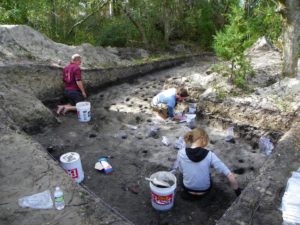
For well over four centuries, early American colonists, historians, and archaeologists have wondered and opined about one of America’s most enduring historic cold case mysteries — the mysterious fate of the first British colonists on American soil — the famous “lost colony” of Roanoke. Now, archaeologists have uncovered some tantalizing new evidence that could pave the way to finally solving the age-old mystery.
The story began over 430 years ago, when Queen Elizabeth’s Sir Walter Raleigh chartered and financed several initial voyages bearing British subjects to the shores of what is today North Carolina, more than two decades before the establishment of James Fort in 1607, the start of the first successful British colony in the Americas. Of the several voyages chartered by Raleigh, only the third one consisted of a mix of men and women with the mandate to establish a true permanent colony with a start-up group of 118 men, women, and children. Explorer John White was commissioned as the expedition’s leader and colony governor. Along with him came his daughter Ellinor and son-in-law Ananias Dare. They established their initial presence on Roanoke Island, but as it turned out, the effort was short-lived. After six weeks, White left the colony to return to England for much-needed supplies and reinforcements, leaving behind the bulk of the group, including his daughter, son-in-law, and new granddaughter Virginia, the first English person to be born on American soil, to thrive as best they could until his return.
He could not return for another three years. When he finally did arrive at the site of the settlement, not a single settler could be found. In a subsequent letter to a friend and colleague, he summed up the mystery and misfortune with the words “as luckless to many, as sinister to myself”.
For decades, archaeologists have been surveying and excavating on Roanoke Island and other locations to find clues to the fate of colony, as well as insights to their presence and activities on the island. Beginning with archaeologist Jean “Pinky” Harrington in 1947 and 1948 in the area now marked by the Fort Raleigh National Historic Site, teams have uncovered a series of artifacts and features at several locations that have testified to the presence of colonists. But other sites further into the mainland and south along the coast have recently yielded intriguing new finds that could tell a story of movement and re-settlement of the original colonists away from the first settlement site on Roanoke. One such location is the Salmon Creek site (now popularly referred to as “Site X”, located inland and adjacent to the western Albemarle Sound), where from 2012 through 2017 archaeologists of the First Colony Foundation recovered 40 sherds representing perhaps 6 or 7 vessels of 16th century Surrey-Hampshire Border ware; 8 sherds representing a North Devon plain baluster jar—both types of ceramic ware commonly used during the 16th and 17th centuries, the baluster jar having been typically used as a provisioning jar on sea voyages; and two tenter hooks, among other artifacts. Most recently, First Colony Foundation archaeologists recovered more 16th century pottery sherds at a site designated Site Y (near the Chowan River, north of Site X). This collection of sherds exceeded that found at Site X. According to archaeologist Nicholas Luccketti, director of the excavations, the finds suggest there was a small contingent of colonists for a short time period at these locations. More compelling still, a significant collection of 16th century European artifacts have been unearthed at sites on Hatteras Island (known in the late 16th century as Croatoan Island after the name of its Native American inhabitants of the time), beginning in the late 1990’s under excavations conducted by David Phelps of East Carolina University, and then from 2012 through 2013 under excavations conducted by the University of Bristol’s Dr. Mark Horton with help from volunteers of the island’s Croatoan Archaeologicl Society. Finds from these two investigations included a late 16th century snaphouse gunlock; a well-preserved 16th century style bronze signet ring; a silver ring—likely once belonging to a woman, given its finger size; an Elizabethan period copper aiglet (likely used at one time to secure the end of a shoe lace); a 16th century Nuremberg token; a 16th century lead pencil and writing slate fragment featuring drawing and other clearly human-made markings; and a fragment of a 16th century swept hilt rapier. These artifacts are but a partial list of the 16th century finds recovered on Hatteras.
Archaeologists plan to continue their investigations both inland from Roanoke Island and south along the coast on Hatteras Island. A more in-depth account of the archaeological explorations can be found in the article, The Case for Hatteras: Unearthing New Clues to America’s Historic “Lost” Colony, published as a major feature premium article in Popular Archaeology Magazine.
__________________________________

The excavation team at work at two of the Hatteras Island excavation units. Courtesy Croatoan Archaeological Society
__________________________________
Advertisement



